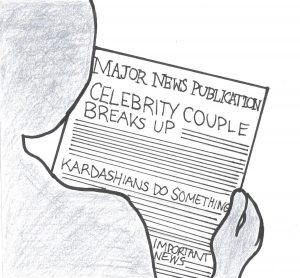The home page of the San Francisco Chronicle website is filled with bold headlines highlighting such scintillating topics as a sign at a pizza restaurant that received “national attention,” an Oscar scandal, and, on a lucky day, Mark Zuckerberg’s neighbors. Far to the right, in a much smaller font, is a mention of a shooting in Santa Rosa. Scroll way down and there might just be a glimpse of a story about decoy cameras at BART stations, or Obama’s $4 billion initiative to fund the testing of self-driving cars.
The Chronicle is not alone. The age of social media has caused countless other publications to favor clickbait over current global issues because the value of a story is directly correlated to the number of shares and likes it gets.

A Pew Research study from October, which examined media coverage of Pope Francis’ visit to the United States, revealed that more stories relied on personal narratives than political narratives: 31 percent used members of the public as sources, while only 12 percent used a member of Congress as a source, and 12 percent used someone from a single-issue interest group as a source.
Only covering certain aspects of important topics will lead to a negative outcome, especially if they are as important as the Pope’s political views and messages, which will shape the Catholic church and the world.
This focus on superficial news trickles down to readers. I’ve heard many friends discuss viral news events they heard about via social media and make claims backed by studies they read on Snapchat. In fact, a Pew Research study from July found that 63 percent of Twitter users and 63 percent of Facebook users reported that they used the sites as a source for news.
While these statistics may not seem problematic, “trending” tags inflate the importance of superficial stories––they allow us to read about the latest celebrity break-up, or a new diet guaranteed to help them lose 20 pounds in a week, rather than the hard truth we need to hear to become informed. The influx of news articles onto social media itself is not a problem, rather it helps the public become more involved in news events. The troubling aspect comes when social media dictates which stories should be read, and which should not. More often than not, it is the stories with little relevance that go viral, leaving articles on other issues go unnoticed. This over emphasis on stories that are composed solely of fluff can distract us from what is actually going on in the world. When reputable news sources publish stories that might have previously only been published in a gossip magazine, they let what the audience wants to hear to overshadow what they need to hear.
I readily admit that I would much rather read a heartwarming story than one about the most recent mass shooting. But just because I don’t like it, doesn’t mean I should ignore it. Not every important event is enjoyable, but that doesn’t mean the less enjoyable ones should be disregarded.
It is vitally important to be informed about world issues so that we can build a better future, solve problems, and become more tolerant of people who have different views and experiences than us. When news coverage skirts away from hard news, and the audience’s only source of news is opinionated social media, we are left with ignorance instead of education. If a news event is shared multiple times and blows up on social media, its exposure and influence will skyrocket and grow exponentially, leaving less viewed stories behind in the dust.
If a well-respected publication prints clickbait stories, it further corroborates the idea that stories written purely for entertainment are important, and that crucial global events should be disregarded. Although readers might not be able to control the media’s attempt to distract them, it is their responsibility to look past the fluffy stories and find out what is truly going on.






